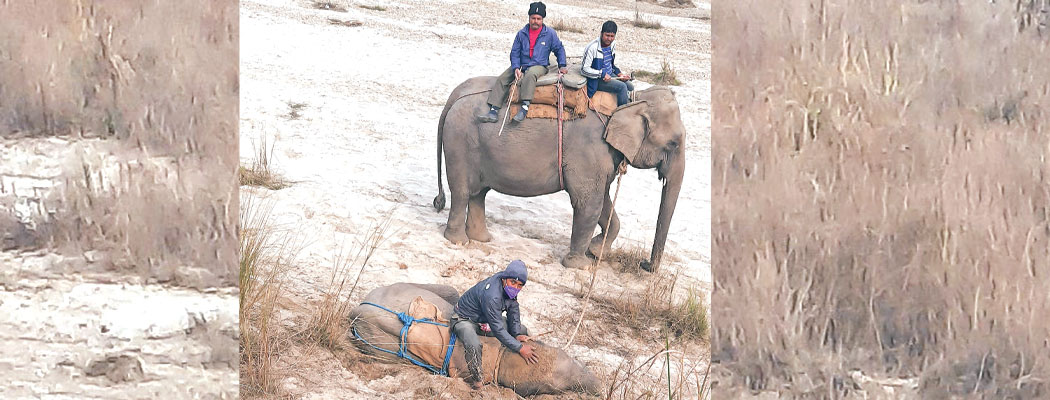
“Sit down,” Rakesh Mahato, the mahout of the Elephant Breeding Centre in Khorsor, gently pushed the head and ear joints of Gopal Gaj (baby elephant) with his foot asking the calf to sit down. And then he slowly pushed the same joint with his foot and instructed the calf to give him the stick on the ground, “Give it to me!”
Having received the instructions of his mahout, the calf picked up the stick and gave it to him. After that, Mahato wanted to put that calf to sleep, pushing his foot on the joint, he said, “Go to sleep”. And that the calf slept calmly on the ground.
Anyone who visits the elephant breeding center can easily see the scene of the calf being trained. The staff of the breeding centre like Mahato have worked very hard to train the calf to follow the instructions.
“The calf will be separated from the mother and gradually trained,” Mahato said. The calf will be taught to walk, lie down, stand up, give the objects to its mahout and ask to do work gradually.”
Gopal Gaj was born as the first child of Himali Kali three-and-a-half years ago. Now Gopal Gaj has received training like other elephant calves. Similarly, Shani Gaj, Khagendra Gaj, Gopal Gaj and Simsar Gaj have been trained in the breeding centre with Gopal Gaj.
Manipuran Mahato, chief of the breeding centre, said, “These calves were first separated from their mothers and tied with two elephants and taught to walk, lie down and stand up.”
He said that three to four year old calf are able to understand the instruction of mahout after only two months of training. During the training, it is customary to worship Goddess Bandevi and Khawari and sacrifice animals in the training centre.
“After worshiping the gods and goddesses in a tantric way, the calves are tied to a khawari pole (special pole) for three to four days without being allowed to sit,” Mahato said. “In this way, we sacrifice animals such as goats, chickens, and pigeons to avoid obstacles during the training,” he said.
After sacrificing animals and birds, the calf, which is tied with a rope to the khawari pole, is given less food and water than usual. If the calf starts causing a lot of trouble while being tied to the pole, fire is lit nearby to control the anger. “We are controlling its anger with the flame of fire,” Mahato told The Rising Nepal.
Because most of the mahouts who train the elephants are Tharus, they are trained using the Tharu language. Especially the calf understands the Tharu language. It is said that elephants are trained by using languages such as Baith (sit down), Agat (go ahead), Sut (sleep) and Evaragat (come here). Elephants that have been trained in this way work by understanding the language and behaviour of their mother.
Taming and training elephants is a challenging task in itself. The mahouts of the breeding centre in Kasara of Sauraha are now busy with this challenging work. Their natural knowledge and traditional skills are the training courses for elephants.
Established in 1984, the breeding centre has overseen the birth to 62 elephants. There is a custom of offering a goat to Bandevi to welcome the calves. The offerings are distributed to everyone in the breeding centre. Since its establishment, the centre has trained 51 elephants. Four calves have been trained this year alone, according to the centre.
Trained elephants are deployed for park security by creating a vacancy. Park’s senior veterinarian Dr. Vijay Shrestha said, “Regardless of where they were born in the park, the only way to train them is to bring them to the breeding centre.”
Six calves born in the centre have died. Currently, five calves are growing up in the centre. Chitwan Kali born from Rampyari Kali in 1984 is the first-born child of the breeding centre.